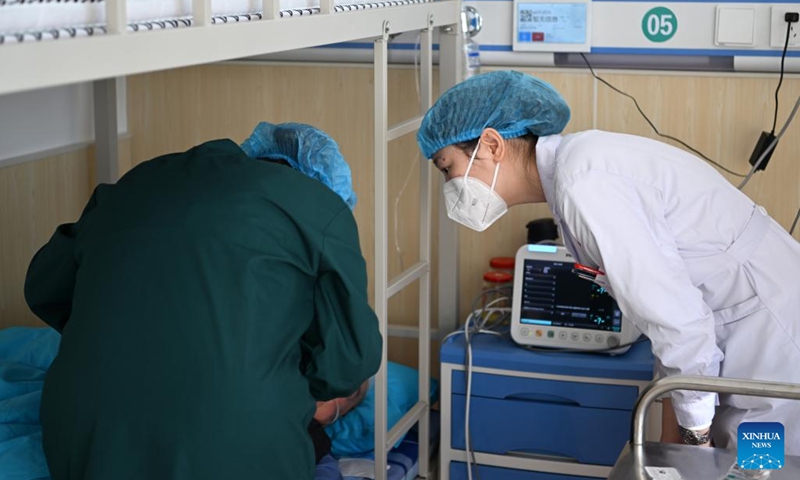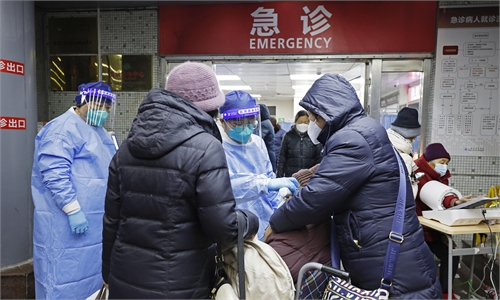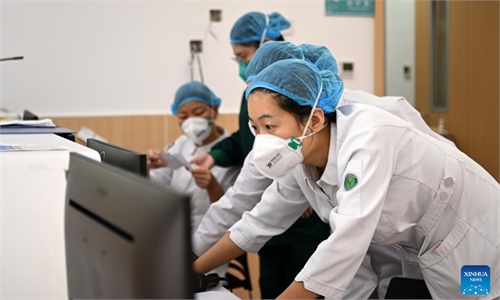China anticipated medical demand ahead of optimizing epidemic controls to protect lives: NHC official

Medical workers treat a patient in a temporary fever clinic at Traditional Chinese Medicine Hospital of Xiqing District, north China's Tianjin, Dec. 28, 2022. To meet the needs of fever patients seeking medical treatment and relieve the pressure on fever clinics in medical institutions, a temporary fever clinic was recently put into use at the new campus of Traditional Chinese Medicine Hospital of Xiqing District in Tianjin.(Photo: Xinhua)
China's top health official from the National Health Commission (NHC) said in an interview that the government had anticipated increased demand for medical treatment while optimizing epidemic prevention management, and was trying to delay peak infections as much as possible by increasing fever clinics and medicines.
The cure rate for COVID-19 in China has remained above 90 percent, even when the outbreak began in Wuhan, Jiao Yahui, director of the Medical Administration Bureau of the NHC, said to the CCTV News, adding that the increase in mortality and severe illness perceived by the public is based on China's huge population, rather an overall increase in proportions.
The National Health Commission issued an announcement on December 26 to downgrade its management of COVID-19 from Class A to Class B starting from January 8, 2023, shifting the focus of the response from stemming infection to caring for the health and preventing severe cases.
Accordingly, people infected with coronavirus will no longer be quarantined and their close contacts will no longer be traced.
Moreover, the newly released coronavirus infection management policy means that China is one step closer to fully opening to the outside, as domestic and foreign airlines will operate scheduled passenger flights under bilateral transport agreements, with limits on flights no longer applicable including closed management, nucleic acid testing, and quarantine measures.
Many cities in China have begun to experience a peak of COVID-19 infections, with the number of infected patients soaring in early December 2022. The number of patients at fever clinics in some hospitals has surged, with some doctors treating as many as 150 patients in one night, according to media reports.
Jiao said in response that the NHC requires all hospitals to open fever clinics to meet the medical needs of fever patients as much as possible. As of December 25, 2022, there are more than 16,000 fever clinics in hospitals at or above the second level across the country, and more than 41,000 fever clinics in community-level medical institutions.
In addition, some gymnasiums, nucleic acid testing sites and makeshift hospitals have also provided support for triage patients and relief of medical pressure in hospitals, where people can access medical consultations and medication.
Responding to the reported "shortage of medication," Jiao said the two main reasons were the hoarding of medicines by the public at the early stages of the outbreak and the surging demand of medicines within a short period of time.
Many medicine manufacturers also face the problem of understaffing due to the epidemic. Moreover, China has a large number of elderly people with underlying diseases who hope to be treated in a relatively small number of top-tier hospitals, so the contradiction between supply and demand became acute, she added.
As the situation progressed, the pressure to treat patients in hospitals began to spread from fever clinics to emergency and intensive care units, with the number of patients treated in intensive care units at many hospitals across the country having tripled over previous levels.
In the face of the sudden increase in the pressure brought by patients admitted to the emergency and the intensive care unit, the NHC requires that patients under observation in the emergency be admitted to the ward within 24 hours. In addition, it is necessary to implement hierarchical health management based on different risk groups, and focus on early intervention and treatment, so as to prevent the occurrence of severe illness, Jiao said.
The characteristics of Omicron's strong infectivity and transmission have caused many people to be infected with the virus, but in fact, the proportion that actually needs to be hospitalized or needs to be admitted to the ICU is still low, said Tong Zhaohui, a respiratory and critical illness expert and director of the Beijing Institute of Respiratory Medicine.
Take Beijing Ditan Hospital and Beijing You'an Hospital, two designated hospitals for the treatment of infectious diseases, as an example. The severe and critical cases among patients admitted in the two hospitals accounted for only 3 percent to 4 percent, Tong added.
Tong noted that severe cases of COVID-19 infection are still concentrated on elderly populations with underlying diseases. The characteristics of high transmissibility and low virulence of the Omicron variant did not change significantly while it is still necessary to be vigilant against the virus.
COVID-19 is not an enhanced version of a cold, Jiao said, but is often compared to influenza, which is caused by a viral infection and is accompanied by systemic symptoms such as fever, cough and even pneumonia.
As Spring Festival approaches, China will witness mass movement of people between different regions, which is bound to lead to the rapid spread of the virus. With a large population but limited medical resources per capita in rural areas, the way to deal with the peak of infection in vast rural areas will be a challenge.
Jiao noted the NHC is making every effort to coordinate medical reserves and resource distribution in rural areas, as well as coordinate resources to ensure that critically ill patients in rural areas can receive timely and effective treatment.
The first and second weeks after the peak of infections tend to be the hardest, Jiao said. The epidemic situation will be gradually brought under control as long as the country gets past the peak of the infection.
Global Times


